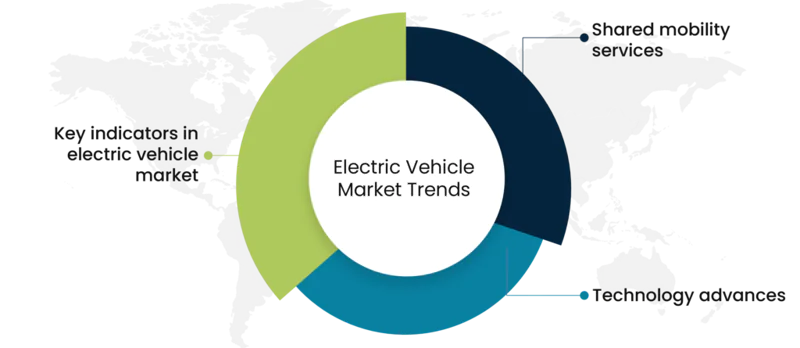Key takeaways
- Rapid EV Market Growth: Global electric vehicle (EV) sales are poised to surpass 5 million units within the next five years, driven by strong adoption in Europe and bolstered by government incentives and market consolidation efforts.
- Technological Advancements: Advances in battery storage technology are driving cost reductions and increasing production efficiency, supporting the expansion of the EV market and its associated supply chain.
- Government Support and Policy: Government subsidies, incentives, and regulations play a pivotal role in shaping the EV market, fostering infrastructure development, emission standards, and public procurement policies to encourage EV adoption and sustainability.
- Expanding EV Ecosystem: The surge in EV battery demand necessitates the expansion of the entire supply chain, from raw material extraction to EV production, promising a sustainable future for electric cars, buses, trucks, and hybrid vehicles globally.
Global electric car market share and size
The electric vehicle sales are expected to reach over 5 million units, globally in the next five years. Europe is expected to witness the fastest growth in the market due to rapidly rising adoption of electric cars in countries such as Norway, Germany, and the UK. Moreover, the rollout of several policies related to electric vehicles is expected to benefit the growth of the electric vehicle market.
Market consolidation and joint ventures among the major firms are being seen as a key factor in the electric vehicle market. Automotive companies have been involved in the geographical expansion of their business through partnerships with domestic firms. These companies are also aiming at synergies to develop more advanced electric vehicles to meet the demand of the market with technological expertise. Apart from this, the growing demand for longer-range electric is projected to create ample growth opportunities for the electric vehicle market companies as these are expected to replace most of the internal combustion engine (ICE)-powered cars.
Companies in the electric vehicle market are addressing market demands to increase their presence in the market. Request a free proposal to gain customized supply market intelligence solutions.
Electric vehicle market trends

Monetary government subsidies
The electric vehicle market has high growth prospects despite the low market size. Governments have plans in place to invest significant amounts to make electric vehicles attractive, but their policies are yet to be implemented. Purchase credits, the free use of charging stations, establishing charging stations, and free parking for electric vehicles are some of the initiatives that will be undertaken by the government to boost the domestic electric vehicle market. Companies should also consider investing in European nations. The size of markets is not yet large, but firms should make use of the dynamic conditions, which are primarily driven by the political agenda. They should be prepared to make use of existing governmental regulations to support electric vehicle purchases.
Shared mobility services
The use of shared mobility services is rising quickly. Over a billion people across the globe now use some form of the ride-hailing app. Such services will continue to grow and reduce the demand for private vehicle ownership. Shared mobility services will adopt EVs faster than private owners, due to attractive economics and government policies. Today, electric vehicles account for approximately 2% of the shared mobility fleet. By the end of the decade, we expect electric vehicles to hold a major portion of the shared mobility fleet.
Incapability to keep pace with the shared mobility fleet category can negatively impact the electric vehicle market growth. Stay a step ahead by contacting our procurement experts to gain detailed market insights.
Technology advances
Recent technology progress for battery storage has been escalated by high demand for batteries in consumer electronics. Structural elements indicate continued cost reductions and are linked to developments such as changes in battery characteristics and the scale of manufacturing plants underway in the automotive sector. The development of manufacturing capacity for automotive batteries reflects the dynamic developments of battery technologies and the importance of electric vehicles to achieve further cost reductions in battery storage, thereby boosting the electric vehicle market.
Key indicators in the electric vehicle market
- Incentives and Subsidies: Governments often provide financial incentives and subsidies to both consumers and manufacturers to promote the adoption of electric vehicles. This may include tax credits, rebates, or direct subsidies for the purchase of electric vehicles. These incentives make EVs more attractive to consumers and help offset the initial higher costs.
- Charging Infrastructure Development: Governments play a significant role in the development of charging infrastructure. Policies that encourage the establishment of a widespread and accessible charging network are crucial for the growth of the electric vehicle market. Initiatives such as funding for public charging stations, regulatory support, and collaboration with private entities are indicators of a supportive environment.
- Emission Standards and Regulations: Stringent emission standards and regulations on conventional vehicles can drive the demand for electric vehicles. Governments may implement policies that encourage automakers to produce a certain percentage of electric or low-emission vehicles, promoting the transition to cleaner transportation options.
- Research and Development Support: Governments often support research and development initiatives in the electric vehicle sector. Funding for innovative technologies, battery research, and improvements in charging infrastructure can accelerate the advancement of electric vehicle technology. These policies signal a commitment to long-term sustainability and competitiveness in the global electric vehicle market.
- Public Procurement and Fleets: Government procurement policies can have a significant impact on the electric vehicle market. When governments prioritize electric vehicles in their own fleets or public transportation systems, it not only sets an example but also creates a stable market for manufacturers. Such policies can drive economies of scale, making electric vehicles more affordable and widely available.
Development: Electric vehicle & charging technology
The rise in electric car registrations has led to an increased production of automotive lithium-ion batteries. In 2022, EV battery demand surged by 65% from the previous year as EV sales continued to grow in all markets. This surge can be attributed to the growing sales of battery electric vehicles (BEV) and plug-in hybrid electric vehicles (PHEV), which require larger batteries compared to hybrid electric vehicles (HEV). To support the increasing demand for electric vehicles, all aspects of the EV battery supply chain, from the extraction of raw materials such as lithium or nickel to the EV production itself, will need to expand. The high demand is driving various developments in battery characteristics, which will bring multiple benefits to the EV business. These developments include changes in battery chemistry, energy density, and the size of battery packs, ultimately leading to cost reductions and increased production efficiency. Several EV manufacturing plants are planning to expand their electric car production capacity due to increased policy support, which is promising news for the market as it means that the supply of EVs will be able to keep up with the demand.
Conclusion
The global electric vehicle (EV) market is experiencing rapid growth, with sales projected to exceed 5 million units globally in the next five years. Europe, led by countries like Norway, Germany, and the UK, is expected to witness the fastest growth in EV adoption. Market consolidation and joint ventures among major firms play a key role in advancing EV technology and expanding market presence. Monetary government subsidies and the rise of shared mobility services further drive EV adoption. Technological advances, particularly in battery storage, are reducing costs and boosting production efficiency in the EV market. Key indicators such as incentives, charging infrastructure development, emission standards, and public procurement policies signal a supportive environment for EV expansion. The surge in EV battery demand necessitates the expansion of the entire supply chain, from raw material extraction to EV production. This expansion, coupled with policy support and advancements in battery technology, promises a sustainable future for the global EV industry, encompassing electric cars, buses, trucks, and hybrid vehicles.




